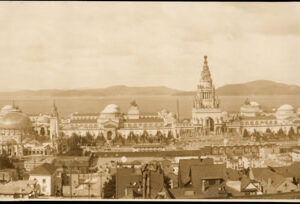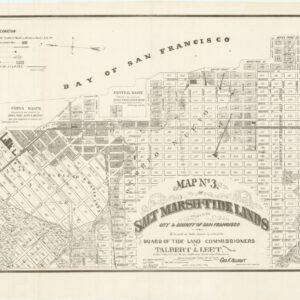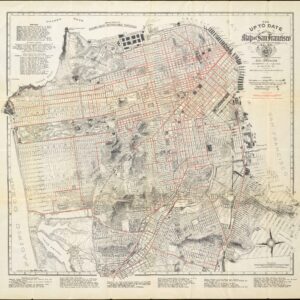A large panoramic photograph of San Francisco’s post-earthquake reconstruction, taken by one of the city’s most famous photographers.
Business District of San Francisco one year after the fire.
$675
In stock
Description
This dramatic panoramic photo of San Francisco, taken one year after the 1906 earthquake, was produced by the local R.J. Waters Company. R.J. Waters was among the West Coast’s most famous turn-of-the-century photographers, and among his most famous themes was the destruction caused by the 1906 earthquake and subsequent fires that ensued throughout the city.
Measuring an impressive 170 x 31 cm (67 x 12 in), the photo provides a panoramic overview of Downtown, in particular the area around Union Square, and with both the Financial District and San Francisco Bay as backdrops. The view spans from north to east, making Lower Nob Hill or the Tenderloin the most likely vantage point. A handrail in the lower right corner of the image suggests that the photographer is standing on the roof of a building, which wouldn’t be unusual at the time.
A number of well-known landmarks are clearly identifiable in the photo. At the front and center, we have Union Square. Some of the visible buildings were, in fact, under construction when the earthquake hit. Standing tallest is the Call Building, identified by its characteristic elevated domes. This was built in the late 1890s by John D. Spreckels to house the family’s newly acquired newspaper: The San Francisco Call.
Conceived and built by architects Reid & Reid, the tower stood 315 feet tall and was crowned by an ornate baroque dome flanked on each corner by a smaller dome. Upon its completion, it was the tallest building west of the Mississippi and quickly became an icon of Californian modernity. The building was badly damaged by fires after the earthquake but remained standing and intact. Known today as the Central Tower (703 Market Street), the building still adorns the San Francisco skyline, although an extensive refurbishment in 1938 reduced its height and removed the magnificent domes.
To the right of the Call Building is another early skyscraper still under construction. The capping dome is unfinished and consists only of skeletal scaffolding, but a billboard at the top carries the name Humboldt. This is the 19-floor Humboldt Bank Building (785 Market Street), which was commissioned by the Humboldt Savings Bank as their new headquarters. Construction on the building began in 1905, but the earthquake destroyed most of the work that had been done. Undeterred, plans were made for a new building immediately, which was completed in 1908 and still adorns Market Street today.
Moving to the left, a number of church steeples are visible, many of which appear to be either severely damaged or surrounded by scaffolding. Looking down Grant Avenue, just left of the center of the photo, we see the ominous outline of the Gothic Revivalist cathedral of Old Saint Mary’s, which was built in 1854. Even further left, at the foot of Nob Hill, another crumbling steeple constitutes the ruins of the original Grace Cathedral (built in 1849), which was so badly damaged by the quake that it had to be torn down and rebuilt from scratch. The steeple of the original building is identifiable by its tall double windows. Beyond this, crowning Nob Hill is the newly built Fairmont Hotel, named after mining magnate and U.S. Senator James Graham Fair (1831–94). The hotel was nearly ready to open when the earthquake struck; while the building itself survived, considerable damage was done to the interior, delaying the hotel’s official opening to 1907.
Context is everything
The San Francisco earthquake struck in the early morning hours of April 18th 1906. It preceded the Richter scale by which we measure earthquakes today by three decades, but calculations have since shown that its force would have been equivalent to about 7.9 on the Richter scale and a Mercali Intensity of XI (extreme). Soon after the tremors had abated, more than thirty fires broke out across the city and raged for four days. Most of these were caused by raptured gas mains, but in some cases they were inadvertently started by local firefighters, such was the confusion of the earthquake’s aftermath. The fires burned intensely hot and since most residential buildings were built of timber and brick, entire neighborhoods burned completely to the ground. It has been estimated that 90% of the total destruction caused by the earthquake resulted from the fires.
When it was all over, more than 80% of the city had been destroyed and more than 3,000 people had lost their lives. The quake was felt as far away as in Nevada, Oregon, and Los Angeles. Modern seismologists still debate the exact epicenter, but most agree that it was just off the coast, northwest of the Golden Gate. The extent of the damage meant that two thirds of the population became refugees over night, and tents and shacks soon began to shoot up on the Presidio, Golden Gate Park, Bernal Heights, and more. Eventually, many of the refugees moved across the Bay to Oakland and Berkeley. Important San Francisco landmarks were lost, including the famed Palace Hotel and City Hall.
In addition to the immediate and short-term impact on the city, the earthquake also had long-term consequences. In 1906, San Francisco was not only the largest and most populous city on the West Coast, but it was also the most important port and bridgehead for American mercantile interests in the Pacific and Asia. Much of this dynamism was lost due to the earthquake. The sheer destruction of basic infrastructure and the chaotic conditions to supply a work force, made maritime engagements difficult. As a result, a lot of trade was diverted south to Los Angeles, and with it followed money and people. In effect, and despite an impressively efficient rebuilding process, San Francisco lost its position as California’s major urban center to Los Angeles, and would not regain it again. This shift has come to characterize San Francisco and most of its contemporary inhabitants would have it no other way. Yet it is a powerful reminder of how easily trajectories can be altered.
The process of rebuilding the city was a long and arduous one. While civic leadership began planning the process immediately, finding the necessary funding proved extremely difficult. There was only a single bank in San Francisco that was willing and able to provide the scope of funds needed for the extensive re-building plans. The Bank of Italy had been founded by Amadeo Giannini, an Italian immigrant who had settled in North Beach. He became a great patron of the reborn San Francisco, providing the city itself with much-needed loans and paying for building materials out of his own pocket. Years later, the bank would be renamed Bank of America, which it is still known as today.
Due to the nature of the devastation and the difficulties in acquiring both funds and materials for the rebuilding, the process took time. But by 1915 the city had recovered to such a degree that it hosted the Panama Pacific International Exposition; a world fair that celebrated the opening of the Panama Canal that summer. This event showcased the city as a hub of modernity where one could experience the concrete results of technological advancement (including a cross-country phone line and the actual Liberty Bell). The exposition proved beyond any doubt that San Francisco had regained its former glory and perhaps now even outshone its former self. For the occasion of the exposition, a glamorous and monumental neighborhood of representative pavilions was constructed along the northern waterfront. Not much remains today, so to get a glimpse of just how impressive the new San Francisco would have been, we are relegated to the Palace of Fine Arts, the most important and imposing of the exposition buildings still standing.
Cartographer(s):
Raper James Waters was born in Virginia City, NV and became a photographer early in life, working out of Gold Hill, NV until he moved to San Francisco. The backdrop to his childhood were years of rapid and at times incredible progress, both in regard to the development of his home state, as well as in regard to industrialization and technology. Waters began his career photographing landscapes in Northern California and Nevada. In 1892, he opened his own commercial studio in San Francisco, from which he sold many of his iconic images.
Waters specialized in urban landscapes and was a pioneer in architectural photography. He won huge renown already during his life time and his photographs are held in world-class institutions such as the Library of Congress, the J. Paul Getty Museum, the Metropolitan Museum of Art, and the libraries of the Universities of California and Nevada.
Condition Description
Printed on thick paper. Scattered minor scuff marks and some minor tears in the margins.
References



